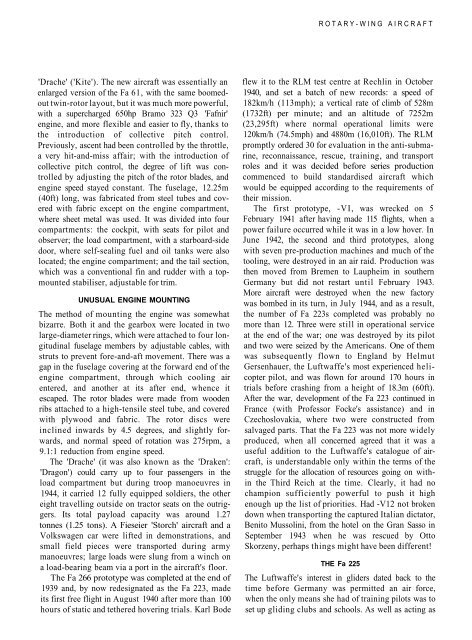Submarines and their Weapons - Aircraft of World War II
Submarines and their Weapons - Aircraft of World War II
Submarines and their Weapons - Aircraft of World War II
Create successful ePaper yourself
Turn your PDF publications into a flip-book with our unique Google optimized e-Paper software.
'Drache' ('Kite'). The new aircraft was essentially an<br />
enlarged version <strong>of</strong> the Fa 61, with the same boomedout<br />
twin-rotor layout, but it was much more powerful,<br />
with a supercharged 650hp Bramo 323 Q3 'Fafnir'<br />
engine, <strong>and</strong> more flexible <strong>and</strong> easier to fly, thanks to<br />
the introduction <strong>of</strong> collective pitch control.<br />
Previously, ascent had been controlled by the throttle,<br />
a very hit-<strong>and</strong>-miss affair; with the introduction <strong>of</strong><br />
collective pitch control, the degree <strong>of</strong> lift was controlled<br />
by adjusting the pitch <strong>of</strong> the rotor blades, <strong>and</strong><br />
engine speed stayed constant. The fuselage, 12.25m<br />
(40ft) long, was fabricated from steel tubes <strong>and</strong> covered<br />
with fabric except on the engine compartment,<br />
where sheet metal was used. It was divided into four<br />
compartments: the cockpit, with seats for pilot <strong>and</strong><br />
observer; the load compartment, with a starboard-side<br />
door, where self-sealing fuel <strong>and</strong> oil tanks were also<br />
located; the engine compartment; <strong>and</strong> the tail section,<br />
which was a conventional fin <strong>and</strong> rudder with a topmounted<br />
stabiliser, adjustable for trim.<br />
UNUSUAL ENGINE MOUNTING<br />
The method <strong>of</strong> mounting the engine was somewhat<br />
bizarre. Both it <strong>and</strong> the gearbox were located in two<br />
large-diameter rings, which were attached to four longitudinal<br />
fuselage members by adjustable cables, with<br />
struts to prevent fore-<strong>and</strong>-aft movement. There was a<br />
gap in the fuselage covering at the forward end <strong>of</strong> the<br />
engine compartment, through which cooling air<br />
entered, <strong>and</strong> another at its after end, whence it<br />
escaped. The rotor blades were made from wooden<br />
ribs attached to a high-tensile steel tube, <strong>and</strong> covered<br />
with plywood <strong>and</strong> fabric. The rotor discs were<br />
inclined inwards by 4.5 degrees, <strong>and</strong> slightly forwards,<br />
<strong>and</strong> normal speed <strong>of</strong> rotation was 275rpm, a<br />
9.1:1 reduction from engine speed.<br />
The 'Drache' (it was also known as the 'Draken':<br />
'Dragon') could carry up to four passengers in the<br />
load compartment but during troop manoeuvres in<br />
1944, it carried 12 fully equipped soldiers, the other<br />
eight travelling outside on tractor seats on the outriggers.<br />
Its total payload capacity was around 1.27<br />
tonnes (1.25 tons). A Fieseier 'Storch' aircraft <strong>and</strong> a<br />
Volkswagen car were lifted in demonstrations, <strong>and</strong><br />
small field pieces were transported during army<br />
manoeuvres; large loads were slung from a winch on<br />
a load-bearing beam via a port in the aircraft's floor.<br />
The Fa 266 prototype was completed at the end <strong>of</strong><br />
1939 <strong>and</strong>, by now redesignated as the Fa 223, made<br />
its first free flight in August 1940 after more than 100<br />
hours <strong>of</strong> static <strong>and</strong> tethered hovering trials. Karl Bode<br />
ROTARY-WING AIRCRAFT<br />
flew it to the RLM test centre at Rechlin in October<br />
1940, <strong>and</strong> set a batch <strong>of</strong> new records: a speed <strong>of</strong><br />
182km/h (113mph); a vertical rate <strong>of</strong> climb <strong>of</strong> 528m<br />
(1732ft) per minute; <strong>and</strong> an altitude <strong>of</strong> 7252m<br />
(23,295ft) where normal operational limits were<br />
120km/h (74.5mph) <strong>and</strong> 4880m (16,010ft). The RLM<br />
promptly ordered 30 for evaluation in the anti-submarine,<br />
reconnaissance, rescue, training, <strong>and</strong> transport<br />
roles <strong>and</strong> it was decided before series production<br />
commenced to build st<strong>and</strong>ardised aircraft which<br />
would be equipped according to the requirements <strong>of</strong><br />
<strong>their</strong> mission.<br />
The first prototype, -VI, was wrecked on 5<br />
February 1941 after having made 115 flights, when a<br />
power failure occurred while it was in a low hover. In<br />
June 1942, the second <strong>and</strong> third prototypes, along<br />
with seven pre-production machines <strong>and</strong> much <strong>of</strong> the<br />
tooling, were destroyed in an air raid. Production was<br />
then moved from Bremen to Laupheim in southern<br />
Germany but did not restart until February 1943.<br />
More aircraft were destroyed when the new factory<br />
was bombed in its turn, in July 1944, <strong>and</strong> as a result,<br />
the number <strong>of</strong> Fa 223s completed was probably no<br />
more than 12. Three were still in operational service<br />
at the end <strong>of</strong> the war; one was destroyed by its pilot<br />
<strong>and</strong> two were seized by the Americans. One <strong>of</strong> them<br />
was subsequently flown to Engl<strong>and</strong> by Helmut<br />
Gersenhauer, the Luftwaffe's most experienced helicopter<br />
pilot, <strong>and</strong> was flown for around 170 hours in<br />
trials before crashing from a height <strong>of</strong> 18.3m (60ft).<br />
After the war, development <strong>of</strong> the Fa 223 continued in<br />
France (with Pr<strong>of</strong>essor Focke's assistance) <strong>and</strong> in<br />
Czechoslovakia, where two were constructed from<br />
salvaged parts. That the Fa 223 was not more widely<br />
produced, when all concerned agreed that it was a<br />
useful addition to the Luftwaffe's catalogue <strong>of</strong> aircraft,<br />
is underst<strong>and</strong>able only within the terms <strong>of</strong> the<br />
struggle for the allocation <strong>of</strong> resources going on within<br />
the Third Reich at the time. Clearly, it had no<br />
champion sufficiently powerful to push it high<br />
enough up the list <strong>of</strong> priorities. Had -V12 not broken<br />
down when transporting the captured Italian dictator,<br />
Benito Mussolini, from the hotel on the Gran Sasso in<br />
September 1943 when he was rescued by Otto<br />
Skorzeny, perhaps things might have been different!<br />
THE Fa 225<br />
The Luftwaffe's interest in gliders dated back to the<br />
time before Germany was permitted an air force,<br />
when the only means she had <strong>of</strong> training pilots was to<br />
set up gliding clubs <strong>and</strong> schools. As well as acting as


